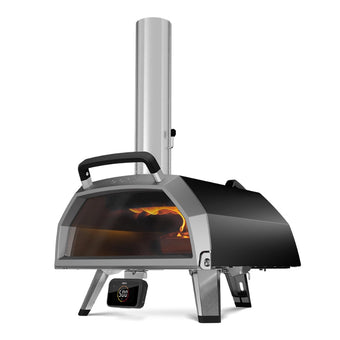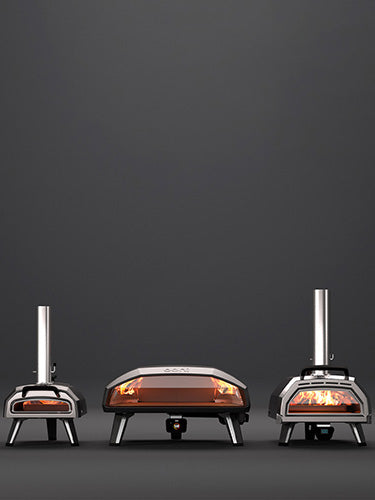When cooking dessert pizza, the last thing you want is to light it on fire. Caramelising baked Alaska? Flambéing bananas Foster? Presenting a figgy pudding? If so, bring on the flames! But for baking sweet pizzas, we’ll take a hard pass on the pyrotechnics.
But baking dessert pizzas topped with sugary ingredients — think marshmallows, frangipane and caramel— in a pizza oven can present challenges. Toppings like these tend to burn and catch flame when subjected to the high temperatures required to cook pizza, especially styles that require longer bakes. The same goes for toppings like nuts and some seeds. (Because they’re tender and prone to bitterness if burned, nuts also benefit from a shorter time in the oven.) So, if you want to have it all — say, a chewy, crispy crust, marshmallows that aren’t blown out, burnt messes, and pecans that are rich and toasty — we recommend parbaking.
You may have heard of parbaking (or blind baking, as it’s also known) in the context of pies and tarts, but it’s just as useful when working with pizza. A parbake is, as the name suggests, a technique for cooking something part of the way. When it comes to pie crusts, this usually involves weighing down the empty pie shell with dried beans or pie weights and baking until the bottom is set and golden brown so it can support the filling. When you’re cooking a pizza, the method is similar, but the techniques vary.
Below, you’ll find some of the most frequently used methods for parbaking pizzas. Some of these approaches may require an extra (but not expensive) accessory purchase; most of them work using standard kitchen ingredients and tools. The methods
Ice cubes
— Some cooks swear by topping pizza with ice cubes right before launching (the idea being that their weight and low temperature slow the bake). The water melts and evaporates away pretty quickly in the oven, but we find that ice cubes tend to slide around on launch and don’t cover the surface of the pizza uniformly (creating a patchy, ballooning effect). That said, you could do worse than this approach.Olive oil
— You can use a similar technique, minus the ice, by applying olive oil to weigh down the crust. Just stretch out the dough, drizzle some oil on top, and launch. As it cooks,turn it often until the crust is set and browned. Though olive oil is obviously much lighter than a set of ceramic pie weights, it will still keep your pizza from turning into an air-filled pita. Keep this in mind, though: Since it’s a fat, the olive oil will add a bit of crispiness to the top of your pizza. If you want to avoid that, try the ice cube or stainless plate baking methods.Docking
— This is one of the most standardized approaches to arresting the rise of the dough. Docking simply involves stretching the dough out to the desired size, then poking holes in a few areas using the tines of a fork. (There are also scores of unitaskers devoted to this practice, but a fork works perfectly well.) The small holes this creates will keep large air pockets at bay and allow the crust to cook evenly.Pan pizza parbake
— Another common tip involves pan pizzas. If this is the pizza style you’re aiming for, shorten your bake (and hold on the sauce and cheese), then depan and flip the crust onto a cooling rack to help flatten the top. For your final bake with the toppings added, return the pizza to the pan right side up — or, if you prefer more texture, take a walk on the wild side and place it in the pan upside down.Parbake and refire
— Sometimes, like in our Nutella, Frangipane and Poached Pear Pizza, we like to parbake, then apply toppings and pop it back in the oven briefly for a bit of color. It doesn’t take long for marshmallows or a layer of sweet almond cream to get deliciously browned.When the parbake
is
the bake
— Other times, like in our Peanut, Caramel and Chocolate Candy Bar Pizza, the parbake is the whole bake. In our example, the pastry cream goes on first, then the rest of the sweet toppings — caramel, chocolate, peanuts — are applied post-bake and soften just enough from the residual heat without needing a refire.Art, not science
Inverted stainless plate bake
— Credit goes to Ooni ambassadors Nic Jackson-Jones (Two Cents Pizza) and Scott Deley (Scott’s Pizza Project) for this simple but ingenious technique. Stretch and prep the dough on a peel. Grab a slightly smaller stainless steel plate (about half an inch shy of the pizza’s full radius) or deep-dish pan, flip it so the bottom faces up, and center it on the dough. Launch and bake until the edge rises with a little color, then retrieve the pizza with a peel and remove the plate so it doesn’t keep baking the dough. (It may be obvious, but we’ll say it: The plate will be HOT, so be careful.) Remember, the dough may puff up around the plate, so the crust may stick in a few places. Just be deliberate and you’ll do fine.The screen method
— Screens can be crutches, it’s true, creating a barrier between the hot cooking surface and the pizza at the expense of actual quality pizza. (It reduces the dough’s oven spring in the name of slowing its rise.) That said, screens can be used as effective tools. Pizza consultant (and former pie guy for the esteemed F&F Pizza in Brooklyn, NY) Tyler Black suggests a similar technique to the plate bake, but swapping in a pizza screen instead.This article features recipes for Nutella, Frangipane and Poached Pear Pizza; Peanut, Caramel and Chocolate Candy Bar Pizza; and Gingerbread Cinnamon Roll Pizza.







